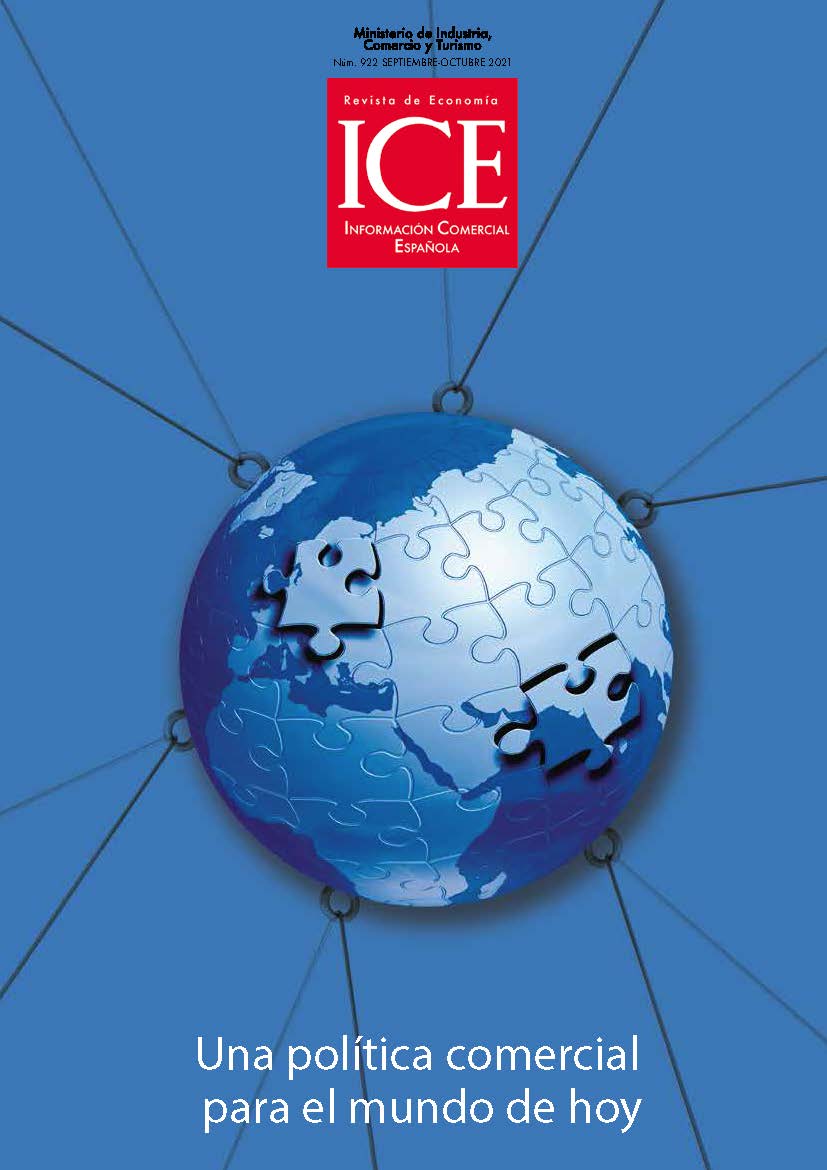Riesgo y rediseño de las cadenas globales de suministro: efectos sobre el comercio y la inversión internacional
##plugins.themes.bootstrap3.article.sidebar##
Descargas
##plugins.themes.bootstrap3.article.main##
Las cadenas globales de suministro y su evolución son, en su vertiente tanto teórica como práctica, uno de los temas económicos de actualidad. El presente artículo aborda el análisis de las cadenas globales de suministro (CGS), en primer lugar, mediante un análisis taxonómico de los riesgos que afectan a estas. A continuación, se formula un modelo teórico que permite identificar los movimientos comerciales y de inversión directa a que dará lugar el ajuste de estas cadenas a nuevos niveles de riesgo. Este modelo teórico facilita el planteamiento de una serie de hipótesis acerca de la evolución futura de las CGS y de la naturaleza y dirección de los flujos comerciales y de inversión a los que su ajuste, previsiblemente, dará lugar.
##plugins.themes.bootstrap3.article.details##
- Juan José Zaballa, La decisión de inversión directa en el exterior: naturaleza, factores y condicionantes , ICE, Revista de Economía: Núm. 909 (2019): Multinacionales en un cambiante contexto internacional
- Juan José Zaballa, El índice de valoración de la inversión española en el exterior: la opinión de las empresas españolas , ICE, Revista de Economía: Núm. 859 (2011): LA NUEVA GEOGRAFÍA DE LA INTERNACIONALIZACIÓN
- Juan José Zaballa, Riesgo y rediseño de las cadenas globales de suministro: una propuesta teórica para una realidad actual , ICE, Revista de Economía: Núm. 929 (2022): El proceso inflacionario en España y el área del euro: un análisis económico
Arriola, C., Guilloux-Nefussi, S., Koh, S. H., Kowalski, P., Rusticelli, E., & van Tongeren, F. (2020). Efficiency and Risks in Global Value Chains in the Context of COVID-19. Organisation for Economic Co-operation and Development (OECD), Department Working Papers No. 1637. https://www.oecd-ilibrary.org/economics/efficiency-and-risks-in-global-value-chains-in-the-context-of-covid-19_3e4b7ecf-en
Bacchetta, M., Bekkers, E., Piermartini, R., Rubinova, S., Stolzenburg, V., & Xu, A. (2021). Covid-19 and Global Value Chains: A Discussion of Arguments on Value Chain Organization and the Role of the WTO. World Trade Organization (WTO), Staff Working Paper No. ERSD-2021-3. January.
Banhan, R. (2014). Political Risk and the Supply Chain. Risk Management, 61(5), 22-26.
Bank of America Global Research. (2020). Tectonic Shifts Identified in Global Supply Chains. BofA Data Analytics.
Barclays Bank. (2020). The post-COVID Economy. Impact Series No. 07. August. https://www.investmentbank.barclays.com/our-insights/The-post-COVID-economy.html?cid=paidsearch-textads_google_google_themes_egs_post_covid_we_research_egs_post_covid_bmm_307153630959&gclid=CjwKCAjwm7mEBhBsEiwA_of-THz-C4alfe8N3jnUqKLQxNU8NXAOT0zkBAQFcSWz36NiaBLTiyKx6hoC9swQAvD_BwE&gclsrc=aw.ds
Dollar, D. (2020). The future of global supply chains: What are the implications for international trade? Brookings Institution. November. https://www.brookings.edu/research/the-future-of-global-supply-chains-what-are-the-implications-for-international-trade/
Gooding, M. (2021). Here’s what we know about the global chip shortage. Tech Monitor. July 9, 2021. https://techmonitor.ai/technology/chip-shortage-tsmc-samsung-us-uk-taiwan-automotive
Gunessee, S., Subramanian, N., & Ning, K. (2018). Natural Disasters, PC Supply Chain and Corporate Performance. International Journal of Operations & Production Management, 38(9), 1796-1814.
Guo, W., Tian, Q., Jiang, Z., & Wang, H. (2018). A graph-based cost model for supply chain reconfiguration. Journal of Manufacturing Systems, 48, 55-63.
Harapko, S. (2021). How COVID-19 impacted supply chains and what comes next. EY. https://www.ey.com/en_gl/supply-chain/how-covid-19-impacted-supply-chains-and-what-comes-next
Hult, G. T. M. (2004). Global supply chain management: An integration of scholarly thoughts. Industrial Marketing Management, 1(33), 3-5.
Paulsson, U. (2004). Supply chain risk management. In C. Brindley (ed.), Supply Chain Risk Management (pp. 79-96). Ashgate.
Porter, M. E. (1985). Competitive Advantage: Creating and Sustaining Superior Performance. The Free Press.
Rao, S., & Goldsby, T. J. (2009). Supply chain risks: a review and typology. The International Journal of Logistics Management, 20(1), 97-123.
Shih, W. C. (2020). Global Supply Chains in a Post-Pandemic World: Companies Need to Make Their Networks More Resilient. Here´s How. Harvard Business Review, 98(5), 82-89. September-October 2020. https://hbr.org/2020/09/global-supply-chains-in-a-post-pandemic-world
Sirilertsuwan, P., Ekwall, D., & Hjelmgren, D. (2018). Proximity manufacturing for enhancing clothing supply chain sustainability. The International Journal of Logistics Management, 29(4), 1346-1378.
Swiss Re Institute. (2020). Reestructurar las cadenas de suministro globales para mitigar riesgos y fortalecer la resiliencia. Sigma n.º 6. https://www.swissre.com/institute/research/sigma-research/sigma-2020-06.html
Tang, C. S. (2006). Perspectives in Supply Chain Risk Management. International Journal of Production Economics, 103(2), 451-488.
UNCTAC, United Nations Conference on Trade and Development. (2020). Informe sobre las Inversiones en el Mundo. Nueva York. https://unctad.org/system/files/official-document/wir2020_overview_es.pdf
UNCTAD, United Nations Conference on Trade and Development. (2021). Key Statistics and Trends: Trade Trends Under the COVID-19 Pandemic. New York.
Vanany, I., Zailani, S., & Pujawan, N. (2009). Supply Chain Risk Management: Literature Review and Future Research. International Journal of Information Systems and Supply Chain Management, 2(1), 16-33.
Zaballa, J. J. (2015). Una propuesta de metodología de cálculo del riesgo país de inversión directa: reflexión teórica y aplicación [tesis doctoral, Universidad Camilo José Cela de Madrid]. Repositorio UCJC. http://hdl.handle.net/20.500.12020/194
Zaballa, J. J. (2019). La decisión de inversión directa en el exterior: naturaleza, factores y condicionantes. Información Comercial Española (ICE), Revista de Economía, 909, 125-141. https://doi.org/10.32796/ice.2019.909.6897


